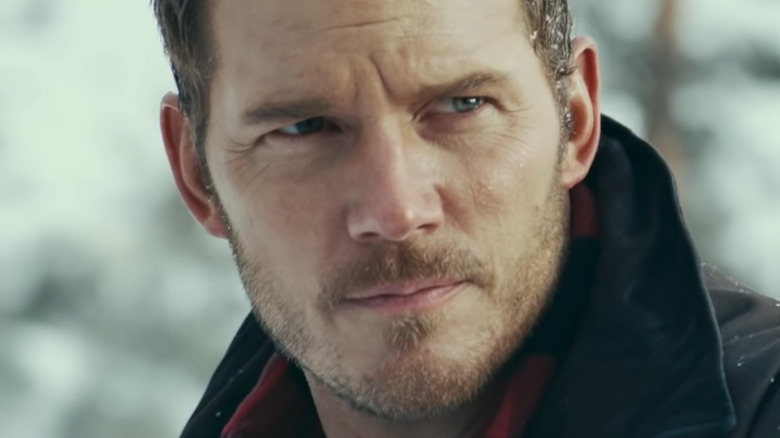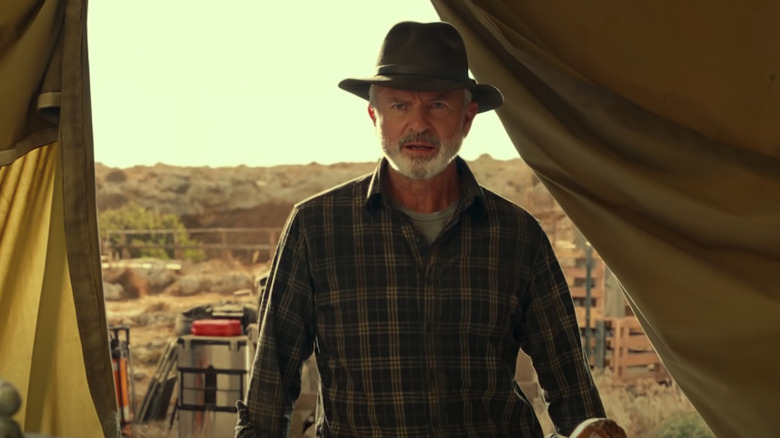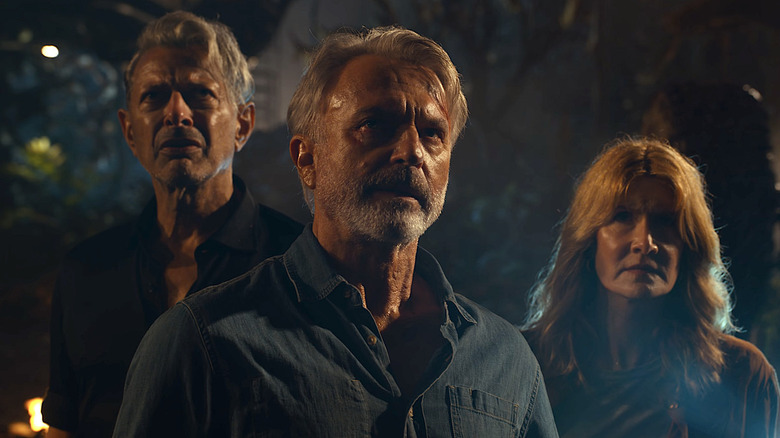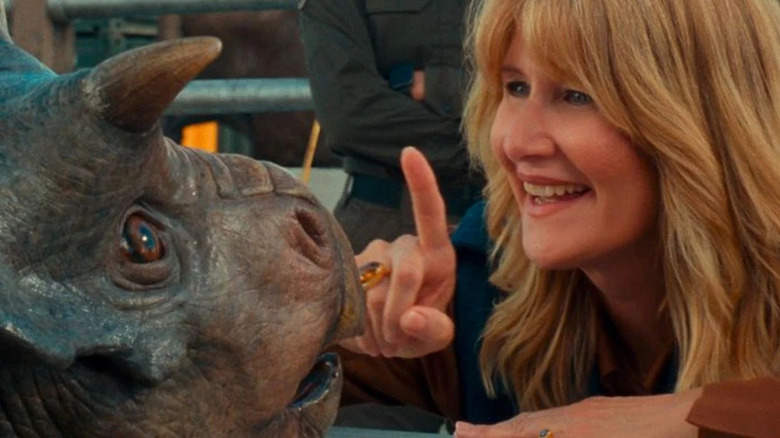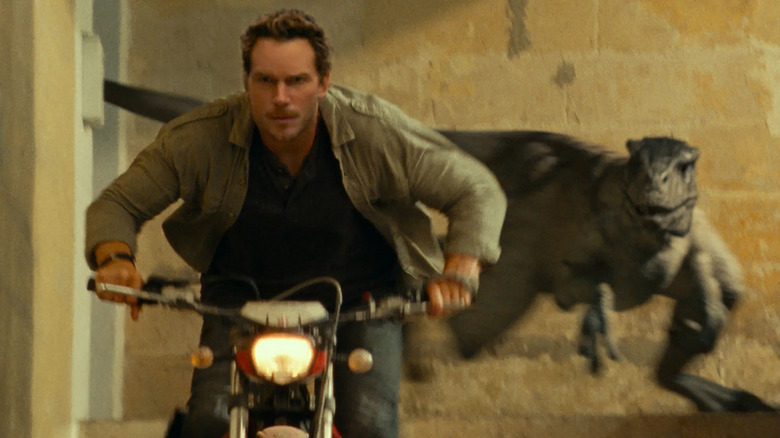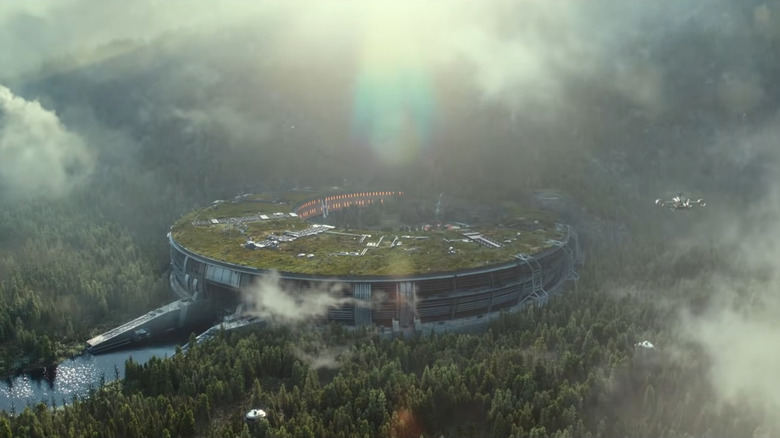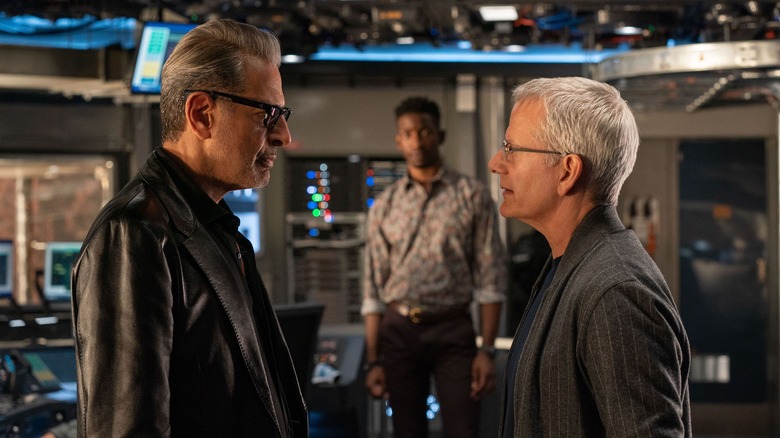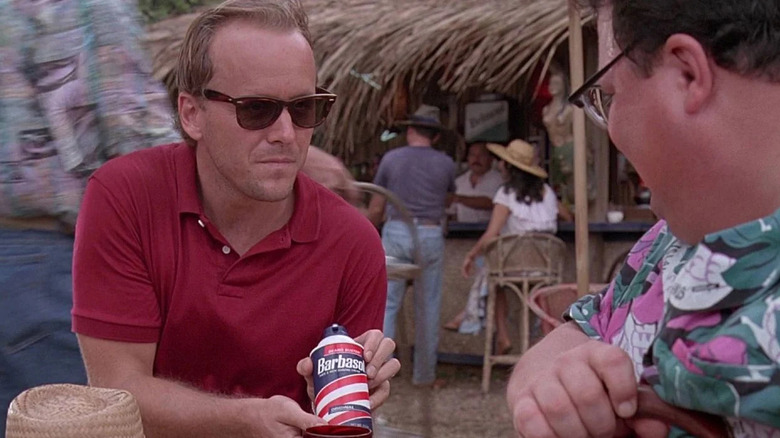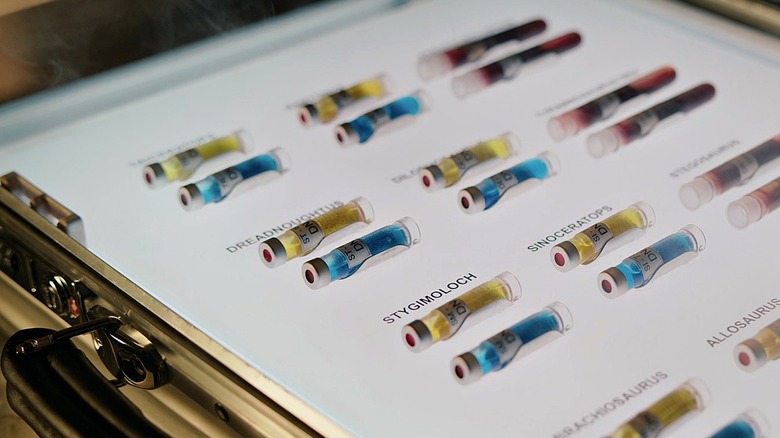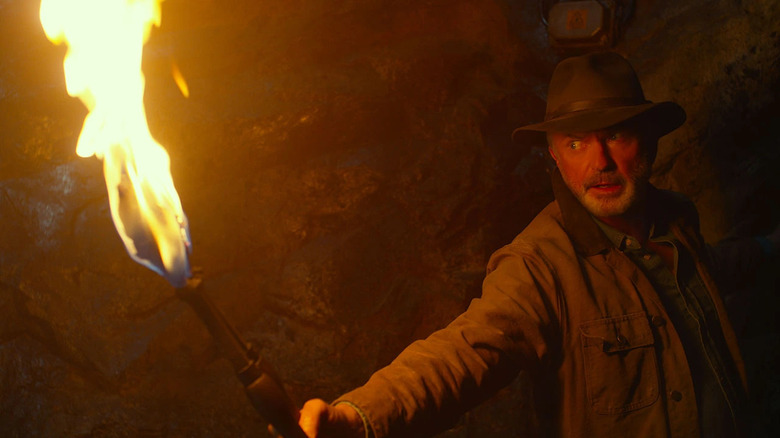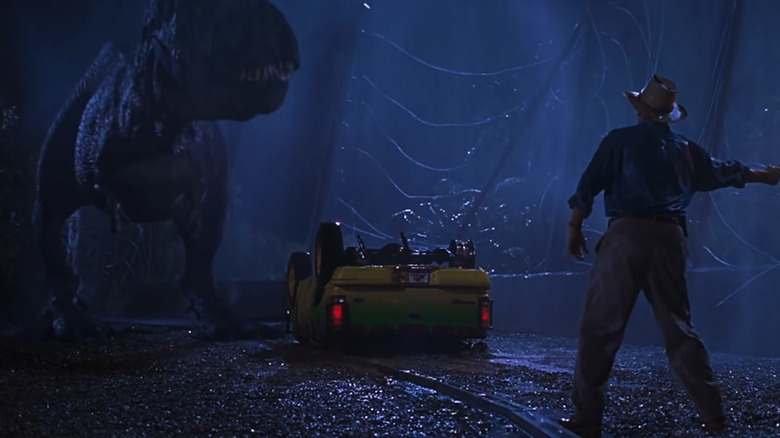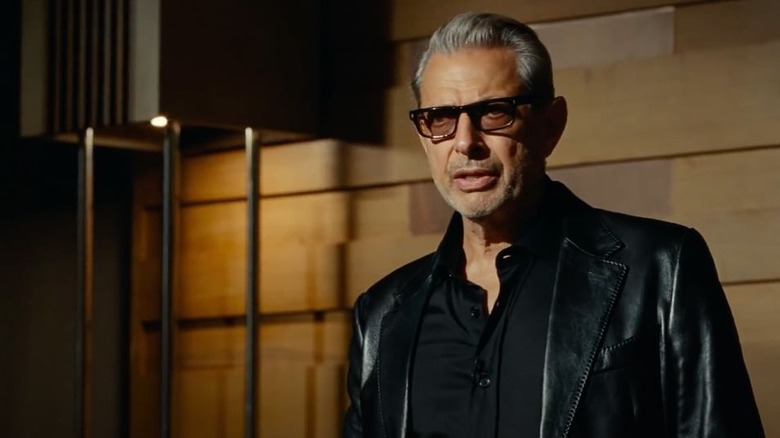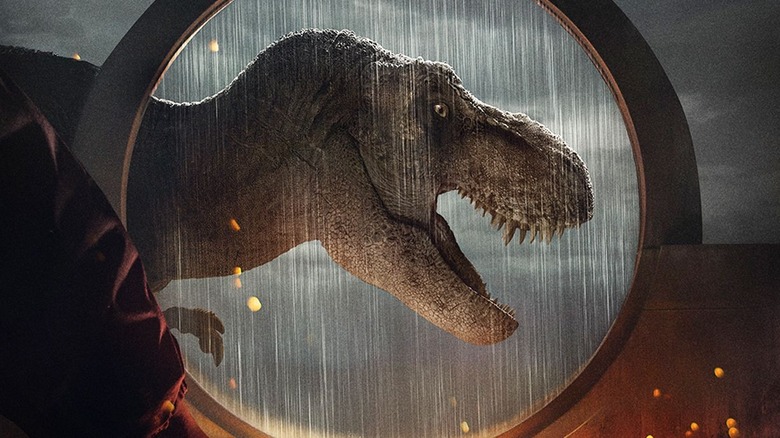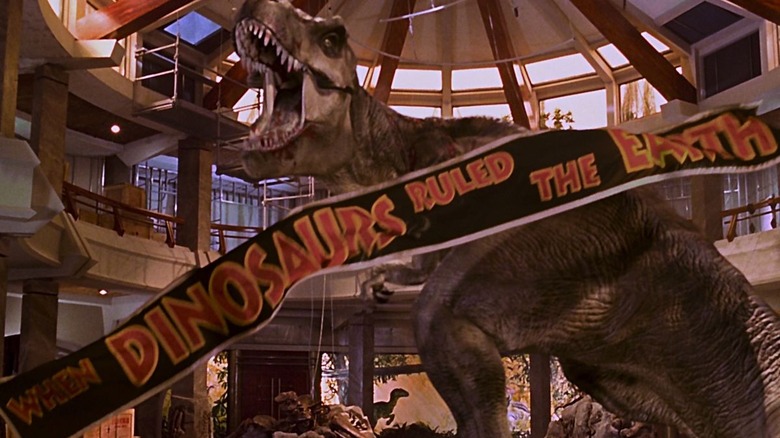Easter Eggs Only True Fans Noticed In Jurassic World Dominion
The "Jurassic Park" franchise hasn't evolved that much over almost 30 years and six movies. The films are still mostly a collection of set pieces in which characters run and hide from dinosaurs, and scientists and CEOs put the world at risk. "Jurassic World" — the first film in the franchise in 14 years — was, in many ways, both a reboot and a soft remake of the original. That means the latest and last installment, "Jurassic World Dominion," has to tie up two trilogies worth of stories with a prehistoric-sized bow.
Audiences knew they were going to get over-the-top action and closure with "Jurassic World Dominion," but they might not have expected quite as many Easter eggs and callbacks to have found their way into the script of "Jurassic World Dominion." Some are funny, some are touching, some are meta, some are a little on-the-nose, and some work better than others, but one thing's for sure ... there are a lot of references to the previous films (not to mention the books and other "Jurassic Park" material) in this final chapter. These are the details that diehard fans of "Jurassic Park" noticed during "Jurassic World Dominion."
Grant and Sattler's reunion echoes the first movie
Near the beginning of "Jurassic Park," Dr. Alan Grant is lecturing about velociraptors at a dig site as Dr. Ellie Sattler listens in. It's implied they're a couple since they talk about the fact that she wants kids and he doesn't. In Alan's humble, slightly cluttered camper-turned-workstation is Dr. Hammond, waiting with an opened bottle of champagne. That's when he recruits them to come to Jurassic Park, to provide testimonials so that he can convince lawyers it's safe to open. The scene effectively serves as the inciting incident for the whole series.
In "Jurassic World Dominion," Ellie finds Alan at a dig site again, where tourists are funding his research. She's waiting for him in his tent, which looks much like his old camper. This time, she recruits him to help end the ecological disaster that Jurassic Park and the subsequent misuse of its scientific breakthroughs have caused. Prehistoric locusts will wipe out the world's grain supply within a matter of weeks, and after visiting a decimated farm that sits next to a Biosyn farm, she hypothesizes that the biotech company is behind the giant bugs.
Dr. Grant quickly hides a photo of the two of them that he's kept all these years. Their relationship ended after the first film, but it's rekindled here, so this scene and its implications operate as a mirror image. Together, they fight to avert disaster, and maybe even find happiness together.
Divorce is a common thread throughout the franchise
Steven Spielberg is a child of divorce; It's a subject that often shows up in his movies, and it's a running theme throughout the "Jurassic Park" franchise, even after Spielberg left the director's chair following "The Lost World." In the original "Jurassic Park," Dr. Ian Malcolm says that he's always on the lookout for the next future ex-Mrs. Malcolm as he explains that he has three kids from multiple marriages (one of them gets more attention in "The Lost World" when his daughter, who he's raising as a single dad, tags along). More important to the plot is the pending divorce of Dr. John Hammond's daughter. That's why he invites Lex and Tim to the island in the first place: to distract them as the bitter court battle between their parents plays out.
In "Jurassic Park III," Paul and Amanda Kirby trick Dr. Grant into taking them to Isla Sorna by pretending to be a wealthy couple, willing to invest in his work. Really, they're the divorced parents of Eric, the boy who went missing while parasailing with his mom's boyfriend. "Jurassic World" recycles the original's plotline by putting Claire in charge of her sister's sons, Zach and Gray, while their parents hammer out the details of their separation, which weighs heavily on the kids despite everyone's best efforts to shield them from it.
"Jurassic World Dominion" makes mention of at least three more divorces. Ian now has five ex-wives, and Ellie is no longer with her husband with whom she has two adult children. Ian's lost loves just add to his character development as an appropriately chaotic chaos theorist, while Ellie's divorce allows her and Alan to reconnect.
Ellie wears an amber ring and still loves sick Triceratops
Although fans have always admired Dr. Ellie Sattler for much more than her personal style, it's hard to deny that her classic ensemble — comprised of a button-down shirt with a t-shirt underneath, khaki shorts, and a great pair of shades — is an iconic look. Working in the elements, Ellie doesn't over-accessorize, so whatever pieces she chooses have to have some significance. Throughout "Jurassic World Dominion," Ellie can be seen wearing a ring that appears to be an oval piece of amber with something trapped inside. This is surely not by accident; it's a clear allusion to Dr. Hammond's walking stick with a mosquito encased in amber from "Jurassic Park."
One of the more memorable moments in the original film comes when Dr. Sattler comforts a sick Triceratops before she searches its scat for an explanation of its ailment. In "Jurassic World Dominion," she sees some recently rescued dinosaurs in a holding area at Biosyn. One of them is a very young, recovering Triceratops that Biosyn took possession of from an illegal breeding operation. Ellie crouches down and examines the little guy's eyesight as she says, smiling, "You never get used to it." This scene calls back to one of her first face-to-face meetings with a real dinosaur: the Triceratops. It also shows that, while Ellie doesn't approve of the way InGen or Biosyn conduct their science, she is still in awe of the actual dinosaurs they produce.
Malta is an ode to Mos Eisley
Colin Trevorrow was Steven Spielberg's hand-picked successor to take over the "Jurassic Park" franchise. Trevorrow directed "Jurassic World" and "Jurassic World: Fallen Kingdom," and he has a screenwriting credit on all three films in the second trilogy. "Jurassic World" was such an enormous hit, in fact, that "Star Wars" came calling next. Trevorrow was slated to helm the "The Rise of Skywalker," but was fired when he and his producers had creative differences during the development process.
Trevorrow apparently still has a fondness for the "Star Wars" galaxy. During one of the most adrenaline-fueled scenes in "Jurassic World Dominion," Owen and Claire go looking for Maisie in an underground market in Malta, where they hope to meet up with Owen's old pal, Barry, who's deep undercover with the illegal traders. Trevorrow told Empire Magazine (via Yahoo) that he was inspired by Mos Eisley and that he wanted his criminal underworld to feel like the notorious hive of scum and villainy in "A New Hope." So if you get cantina vibes from the color palette, the mysterious strangers, and the otherworldly creatures in cages and fighting pits — it's intentional.
Biosyn was InGen's competitor from the start
If it's been a while since you've seen the first "Jurassic Park," or if you've never read the Michael Crichton book upon which it is based, you might think that Biosyn is just the latest stand-in for any nefarious multinational biotech company. At the beginning of the film, we learn that Biosyn won a government contract to provide dinosaurs with a sanctuary at their old amber mines, where they'll study their DNA for the purposes of making advancements in human healthcare. But really, Dr. Lewis Dodgson is trying to control the world's food supply with Biosyn-branded crops that can't be eaten by his secretly Biosyn-branded giant locusts.
Biosyn has actually been a major player in the "Jurassic Park" story since the very beginning. In the novel (and to a lesser extent, in the first film), Biosyn is InGen's rival, and it's desperately trying to keep up with the competition's progress, often through unsavory practices like stealing intellectual property. The book notes that Biosyn — which was then led by CEO Bill Steingarten and headquartered in Cupertino, California — had three subsidiary companies: NutriSyn, PharmaSyn, and Nano League Technologies. In that way, the novel foreshadows the rise of the Biosyn we see in "Jurassic World Dominion," an unethical corporation playing fast and loose with food and medicine.
Dr. Lewis Dodgson is a returning character
Dr. Lewis Dodgson is a villain of more consequence than Giganotosaurus ever could be, as he's coldly able to turn a blind eye to global famine as long as he retains power. The casually dressed, malevolent tech bro is fast becoming a new villain archetype, variations of which can be seen in "The Mitchells vs. the Machines" and "Don't Look Up." But Dodgson isn't a new character. He's portrayed by a new actor (Campbell Scott), but he first appeared as a minor character in "Jurassic Park," played by Cameron Thor.
In the earlier movie, it's Dodgson who meets Nedry at a beachside restaurant in Costa Rica to deliver the tricked-out Barbasol can in which Nedry smuggles the dinosaur embryos. Dodgson is aiming for discretion during their meet-up, but Nedry teases him for looking like a secret agent in his hat and sunglasses. "18 minutes and your company catches up on 10 years of research," he says, as he strong-arms Dodgson into paying the bill.
Three decades later, a silver-haired Dr. Lewis Dodgson is now CEO of Biosyn, and his biotech firm makes InGen look positively charitable by comparison. Biosyn's level of corruption is something else, as is Dodgson's callousness toward human and non-human life alike.
The Barbasol can survived
The Barbasol can with a secret, temperature-controlled compartment for dinosaur embryos is one of "Jurassic Park's" most iconic props. Viewers probably assumed it was lost for good when Nedry wrecked his jeep, got spat on to death by Dilophosauruses, and dropped it into a puddle of mud down a hill. Miraculously, that can shows up again in "Jurassic World Dominion," where Dodgson appears to own it as part of some sort of personal collection. How did the can get from the muck of Isla Nublar to the mountains of Northern Italy? For that story, you'll have to turn to your video game console.
"Jurassic Park: The Game" features a storyline in which two Biosyn employees go looking for Nedry (and, more importantly, the can) after he doesn't make it to the drop point. Depending on the choices the player makes, different circumstances befall the Barbasol can. However, since Biosyn sent people after it, we can imagine that it ended up in Dodgson's hands eventually, which may have precipitated his rise to CEO.
Dreadnoughtus embryos were seen in Fallen Kingdom
Dr. Henry Wu is one of the "Jurassic Park" franchise's cautionary tale characters. In the original, he's a young and overconfident scientist who fails to see the flaws in his gene-splicing plans. He's eager to push the limits of what science can do, as we see in "Jurassic World," where he's easily seduced by new park owner Simon Masrani's interest in creating dangerous hybrids. Though he gets redeemed in "Jurassic World Dominion," he's still beholden to the bad guys for most of the new trilogy. In "Jurassic World: Fallen Kingdom," he escapes with a briefcase full of vials containing embryos labeled with the names of various species of dinosaurs. Among them is one that hadn't appeared in the franchise until now: Dreadnoughtus.
Dreadnoughtus is a recent discovery made by paleontologists Kenneth Lacovara, Lucio M. Ibiricu, Matt Lamanna, and Jason Poole in 2014. This South American titanosaur from the Cretaceous period may have been the largest land animal of all time. In fact, its name means "fears nothing," since, at 85 feet long and 65 tons, there were likely few predators that could have taken it down. Dreadnoughtus appears in the valley of Biosyn's sanctuary in "Jurassic World Dominion," which is foreshadowed by this quick shot of the contents of Wu's briefcase.
Dr. Grant's hat is a reference to Indiana Jones
Among the many blockbusters that Steven Spielberg directed are the "Indiana Jones" films, and in them, Harrison Ford's Indy is never without his hat. There's an oft-parodied moment in "Indiana Jones and the Temple of Doom," in which said hat is just out of reach as a trap door is closing. Against reason, he rolls forward to grab it just in time.
It's easy to see the similarities between Indiana Jones and Dr. Alan Grant. One's an archeologist, while the other's a paleontologist. They're both a little grumpy and they both avoid commitment as much as they possibly can. Not only does Dr. Grant traverse tunnels with a lit torch, as Indy does in his own movies, but he also gets his own ill-advised hat roll moment when he, Ellie, and Maisie are running from Dimetrodons in the flooded amber mines. This is definitely an homage to Spielberg and to the character of Indiana Jones from another gritty but secretly kind-hearted adventurer.
The Giganotosaurus attack calls back to T. Rex's rampage
The most readily apparent reference to the original "Jurassic Park" comes about three-quarters of the way through "Jurassic World Dominion," when all of our protagonists are finally in one place together. Owen and Kayla have tracked down Claire. Ian (with an assist from Ramsay) has rescued Alan, Ellie, and Maisie, and when their vehicle takes a tumble, Owen and Claire recognize Maisie's cries. Just when they think the worst is behind them, a Giganotosaurus approaches the site of the crash. What follows is a fairly faithful recreation of the famous T. rex scene from the original.
Our heroes hide behind the flipped car, but as the gigantic predator turns the corner, they have to crawl through the broken windows to the other side. Dr. Malcolm gets stuck under the upside-down wreckage as the Giganotosaurus spins it around like a toy. Luckily, it's distracted with a torch, allowing everyone to flee to safety. But the apex predator's attack isn't over. While in the original "Jurassic Park" film, the T. rex wanders off after Dr. Grant, Lex, and Tim escape down a cliffside, in this iteration, the Giganotosaurus follows the crew up the observation tower ladder until it's had enough of being prodded, zapped, and shot.
Dr. Ian Malcolm buttons up his shirt
Perhaps the funniest Easter Egg in "Jurassic World Dominion" is a fleeting reference to a fan-favorite scene from "Jurassic Park" that has since become a popular meme. Jeff Goldblum was one of the biggest stars in the original cast at the time the film premiered. He was known for sci-fi movies and body horror thrillers, and was, for lack of a better word, a genre film sex symbol. Goldblum added to his reputation with his performance as Dr. Ian Malcolm, thanks to a scene in which an injured Ian reclines with his chest bared as an unbuttoned black shirt drapes to his sides. The image would become so famous that it was eventually memorialized in toy form by Funko and Mattel.
Dr. Ian Malcom wears a black button-up shirt again in "Jurassic World Dominion," and, though he's about 30 years older, he can still pull off the look — even if Kayla doesn't think so. Once they're all far enough away from the Giganotosaurus, she notices that his shirt has come unbuttoned in the scuffle. He looks down at his chest as she gestures for him to button it back up. We're not sure the internet agrees, Kayla.
T. rex makes itself a logo
Apparently, even 65.5 million-year-old theropods enjoy meta-humor.
Biosyn's facilities in Italy have the all-white and ultra-modern look of a 21st-century tech company, complete with zen-like architecture and landscaping. The minimalism, bright lights, and clean lines actually add to the sense of foreboding, as we know things are going to get pretty messy by the time "Jurassic World Dominion" is over. As the film comes to its violent conclusion, and the forests are burning with panicked, flaming locusts, the Biosyn employees who've remained activate implants in the living assets and corral them into a containment area. Meanwhile, Kayla is waiting to evacuate everyone in one of Biosyn's sleek planes.
Giganotosaurus gets in between the humans and the plane, but he's just the first predator on the scene. Kayla had warned Owen earlier that Dodgson was arrogant and short-sighted enough to put two apex predators in the same territory. Sure enough, T. rex saunters into view and stands in profile behind a circular sculpture just long enough to compose a live-action version of the "Jurassic Park" logo. The final brawl in which Therizinosaurus gets in on the action to help T. rex kill Giganotosaurus is also reminiscent of the franchise's other dino-on-dino-on-dino melees involving T. rex, Velociraptor, Spinosaurus, Indominus rex, Mosasaur, and Indoraptor.
The final film corrects some faulty science
The "Jurassic Park" movies are just as notorious for botching their real-world science as they are for topping the box office: Most paleontologically-minded grade-schoolers can rattle off a list of the things that are wrong with the way dinosaurs are depicted. "Jurassic World Dominion" still makes some mistakes, but it uses its script and its new creature designs to correct some longstanding errors.
In the original, Dr. Grant tells a bratty kid who doesn't think Velociraptors are scary that their six-inch retractable claws would've been used to disembowel him. His dialogue in "Jurassic World Dominion" sets the record straight, as he clarifies paleontologists now think they would've just gone for the neck. This is closer to the truth; these small raptors would've used their small claws to pin down prey, but you can only retcon the lore of a six-film franchise so much.
The final "Jurassic Park" film also fixes some visual and audio problems. Theropods like raptors, T. rex, and Giganotosaurus are mostly shown with their palms facing inward instead of dangling downward, as they should've been, and their vocalizations sound more like a low bird or reptile bellowing than lion roars, which is also an improvement.
